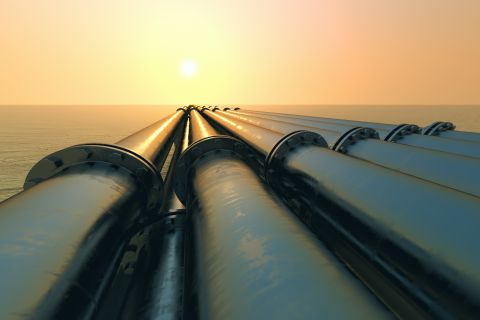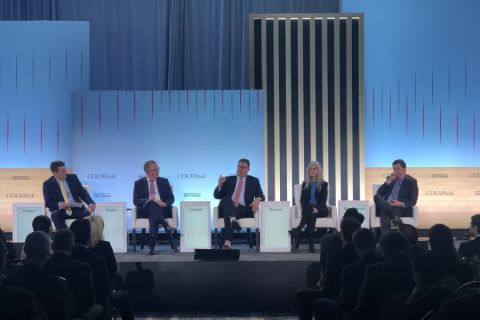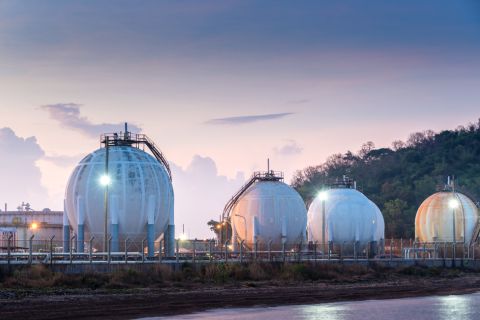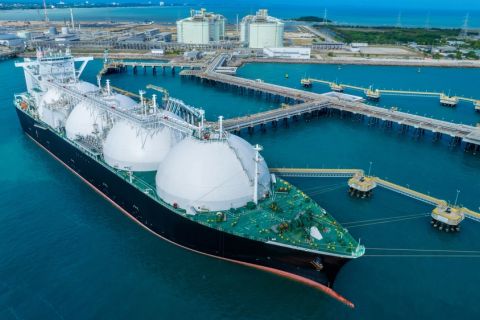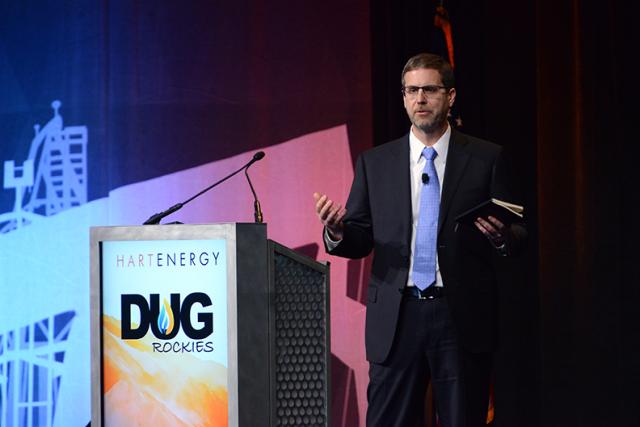
Jay Knaebel, Oasis Petroleum, addresses DUG Rockies (Source: Hart Energy)
DENVER—Like reports of Mark Twain’s premature passing more than a century ago, recent comments about the decline of the Bakken in this century are greatly exaggerated. New regional pipeline takeaway capacity and improved completion techniques—not to mention a declining commodity price differential—are improving oil and gas prospects in the Bakken.
That was the word from Jay Knaebel, vice president, reservoir engineering for Oasis Petroleum Inc. (NYSE: OAS)
“This industry is alive: it’s thriving, it’s dynamic, it’s innovative,” Knaebel told attendees at Hart Energy’s recent DUG Rockies Conference & Exhibition. “There is a long list of adjectives you could use to describe this industry. Dead is not one of them.”
The Bakken has been good for Oasis Petroleum. Founded in 2007 as a Bakken pure play by a management team of former Burlington Resources alumni, Oasis went public with just over 3,000 barrels of oil per day (boe/d) in Bakken production in 2010. Current production exceeds 75,000 boe/d. The company’s Bakken holdings have grown to over 500,000 net acres, including more than 1,000 net locations that can generate positive economics at oil prices below $45.
Oasis remained a Bakken pure play until 2017 when the company acquired 22,000 acres in the Permian Basin along the Winkler/Loving/Ward county lines. Still, the Bakken remains the primary focus for Oasis and is serving a laboratory for innovation where rapidly advancing learnings from full field development can be transferred to future development in the Permian Basin.
Oasis will spend $800 million in 2018 to fund 15% to 20% growth in the Bakken on a four or five-rig program targeting 100 wells annually, and a one or two-rig, 16 to 20 well program, in the Delaware Basin. The effort will be funded out of free cash flow from the E&P division. Oasis has been free cash flow positive for the last three years and was one of the first E&Ps to embrace the new Wall Street mantra of living within cash flow.
Separately, Oasis will divest upwards of $500 million in non-core Bakken acreage by mid-year 2018, boosting balance sheet liquidity above $1 billion.
Additionally, Oasis announced pricing for $400 million in senior notes at 6.25% due 2026 in a private placement at the end of April. The offering is expected to close in mid-May. Proceeds will pay down higher cost debt.
Oasis utilizes an integrated business model that incorporates stimulation services from two company-owned stimulation fleets and, more recently, a separately operated midstream gas processing and takeaway division—Oasis Midstream Partners LP (NYSE: OMP)—that enables the company to grow, even in a services-constrained market.
Knaebel credited vertical integration as a significant factor in well cost reduction. Oasis Well Services division’s two stimulation fleets are generating a threefold EBITDA return on capital invested while serving as a hedge against service cost inflation. There is discussion of starting a third stimulation spread for use in the Delaware Basin.
Adoption of next generation enhanced stimulation techniques is improving individual well performance while simultaneously reducing well costs, turning more acreage into Tier 1 classification. Oasis just upgraded its Painted Woods acreage in western North Dakota from “core extended” to “core,” which means wells are profitable at $40 oil or better.
“We’re feeling really confident about Painted Woods,” Knaebel said. “As a result, our core inventory actually grew this year to 585 net locations. In total, in the core and the extended core, we have over 1,400 gross drilling (Bakken) locations and all of those have breakeven oil prices of $45 oil or better.”
The Painted Woods upgrade follows the implementation of new completion techniques and targeted well spacing that have the net effect of bringing production forward. Oasis uses a “concurrent development” philosophy in which the company performs all its infield activity within a given DSU (drilling spacing unit) at the same time. That includes using two to three rigs to drill wells in each DSU and completing wells simultaneously so that the entire DSU is brought on as one project.
One example includes its Johnsrud unit in McKenzie County, which was the first Oasis DSU brought on line to fuel its midstream processing plant. The 2015 project involved 15 wells and peaked at 14,000 bopd. Since then, Oasis has repeated this practice across additional DSUs and plans to export the concept to its Delaware Basin acreage.
The company’s move to full field development has reduced well costs by $4 million, half through efficiency gains. Since 2010, Oasis has completed 800 wells averaging 10,000 feet of lateral in multiple zones. According to Knaebel, Oasis ranks 2nd among eight Bakken peers with finding and development costs at $10.40 per barrel and ranks second in margin per barrel among 12 Bakken peers at $35.07. Oasis features 75% IRRs in the Bakken.
Oasis launched its midstream processing division a couple years ago, which was recently reconstituted as an MLP for the initial public offering in 2017. The midstream processing entity is expected to grow 45% in 2018 while the distribution per share is projected to rise 20% as the system moves from captive for Oasis to open to additional E&Ps. Oasis plans to process 320 mmcfd by year-end 2018. The midstream unit incorporates local oil and natural gas gathering systems as well as fresh water distribution and produced water handling and disposal systems at the lease level.
“Oasis is in the Bakken for the long term,” Knaebel said. “We consider it home base, and we consider it has world class inventory.”
Oasis has employed a philosophy based on another Mark Twain quote. The secret to getting ahead, the 19th century humorist explained, is getting started. Oasis is finding it’s starting to look up once again in the Bakken.
Richard Mason can be reached at rmason@hartenergy.com.
Recommended Reading
Midstream Builds in a Bearish Market
2024-03-11 - Midstream companies are sticking to long term plans for an expanded customer base, despite low gas prices, high storage levels and an uncertain political LNG future.
Heard from the Field: US Needs More Gas Storage
2024-03-21 - The current gas working capacity fits a 60 Bcf/d market — but today, the market exceeds 100 Bcf/d, gas executives said at CERAWeek by S&P Global.
US NatGas Futures Hit Over 2-week Low on Lower Demand View
2024-04-15 - U.S. natural gas futures fell about 2% to a more than two-week low on April 15, weighed down by lower demand forecasts for this week than previously expected.
US Expected to Supply 30% of LNG Demand by 2030
2024-02-23 - Shell expects the U.S. to meet around 30% of total global LNG demand by 2030, although reliance on four key basins could create midstream constraints, the energy giant revealed in its “Shell LNG Outlook 2024.”
CERAWeek: JERA CEO Touts Importance of US LNG Supply
2024-03-22 - JERA Co. Global CEO Yukio Kani said during CERAWeek by S&P Global that it was important to have a portfolio of diversified LNG supply sources, especially from the U.S.

